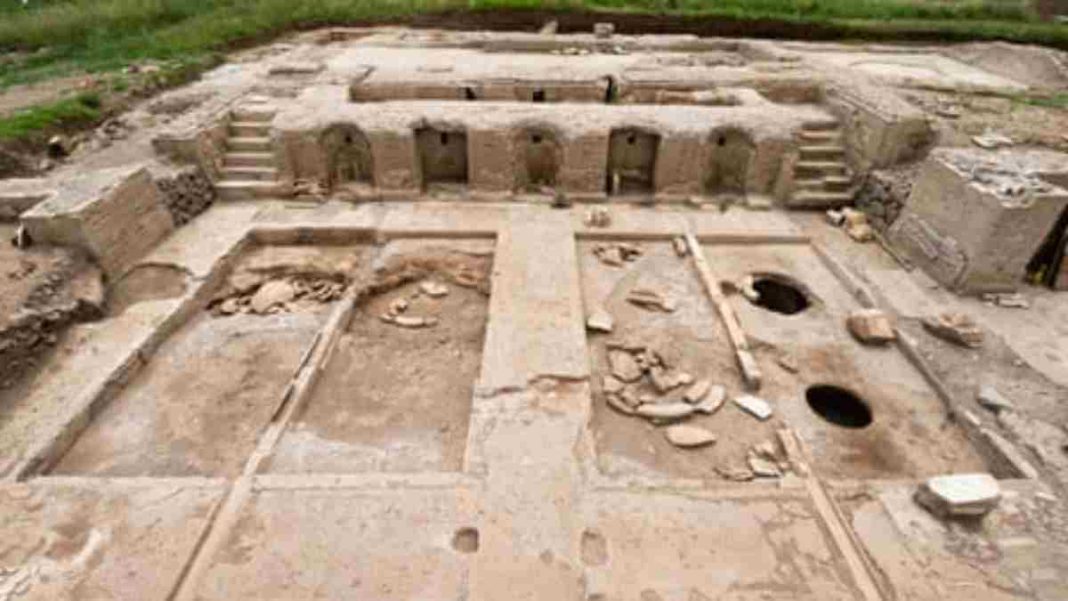ITALY. Rome: One of the Roman ruins that dot what is now a magnificent landscape of pine trees and meadows, beneath the watchful eye of the Alban Hills, is the Villa of the Quintilii, which is perhaps the most remarkable—almost a city in miniature that spans up to 24 hectares.
Nestled on the ancient Appian Way as it travels southeast from Rome, the villa had its own theatre, a bath complex, and an arena for chariot races, with walls and floors lined in luxurious marble.
But the tale of the villa, whose origins date to the second century AD, has just become even more fascinating with the discovery of a complex vineyard that rivals none in the Roman world for extravagantness.
The facility had several opulent eating areas with a view of fountains pouring young wine. The newly gathered fruit would be stamped down by slave labourers in marble-lined spaces, perhaps with the emperor watching while he dined with his entourage.
The ancient winery was situated in an area that was once a landscape of orchards and agricultural lands, filled with grand tombs and the villas of the ultra-wealthy, as well as just beyond the city boundaries of Rome.
Archaeologist Dr. Emlyn Dodd, associate director of the British School at Rome and an expert on ancient wine production, described the Villa of the Quintilii as “an amazing mini city completed by a luxury winery for the emperor himself to indulge his Bacchic tendencies.” He has written an article for the academic journal Antiquity that details the findings of the archaeologists.
As they were looking for one of the starting posts for the villa’s arena, archaeologists from the Italian Ministry of Culture unintentionally came across the ancient Roman grapevine. The Roman emperor Commodus, who ruled from AD 177 to AD 192, constructed the chariot-racing track. The later winery had, as it turned out, covered one of these beginning gates.
The wealthy Quintilii brothers, who were the villa’s original owners, perished in AD 182-183 at the hands of the infamously cruel Commodus. Following that, the imperial emperors took personal control of the complex and, over the years, expanded and altered it.
The fact that the name Gordian is engraved on a big wine collection vat suggests that the emperor likely built or renovated the winery. It would almost probably be Gordian III, given a date of AD 238–244, as the first and second emperors of that name both ruled for only a few days each.
At the villa, which is accessible to the general public, Dodd highlighted the recently unearthed rectangular wine trading areas.
“Usually these treading areas would be covered in waterproof concrete,” Dodd said, adding, “But these were covered in red marble. which isn’t ideal, as marble gets incredibly slippery when wet. But it shows that whoever built this was prioritising the extravagant nature of the winery over practical considerations.”
After being trodden, the downtrodden grapes were then transported to two 2-metre-diameter mechanical presses that were nearby. The resulting grape must be then poured into three fountains, which erupted from semicircular recesses carved into a courtyard wall. There were actually five fountains, with two of the exterior spouts ejecting water.
The grape must be poured from the fountains and then rushed along open channels into enormous ceramic dolia, or storage jars, buried in the ground. This method of winemaking was common in ancient Rome because it offered a stable microenvironment for fermentation.
Around three sides of this spacious courtyard area were covered dining rooms with broad, open entrances. According to Dodd’s theory, the emperor would have feasted and taken in the entire theatrical display of winemaking here.
Dodd would like to obtain funds to unearth all of these dining rooms, but only one has been excavated. This dining room’s walls and flooring were covered in multicoloured inlaid marble veneers in intricate geometric designs.
The entire building appears to have been planned with both the practicality of making wine and the sheer theatricality of it in mind.
Letters from a former emperor, Marcus Aurelius, attest to his having feasted while observing the process of winemaking, possibly at a luxurious winemaking facility at the Villa Magna, 30 miles to the south-east, which is the only comparable site in the archaeological record to the newly discovered winery.
Dodd speculates that the emperor and his entourage may have made a yearly trip to the Villa of the Quintilii to officially launch that year’s vintage with a ritual and a lavish dinner that was undoubtedly inebriated.
Also Read: Top 5 Beaches in Spain to Enjoy the Mellow Tropical Sun This Year



